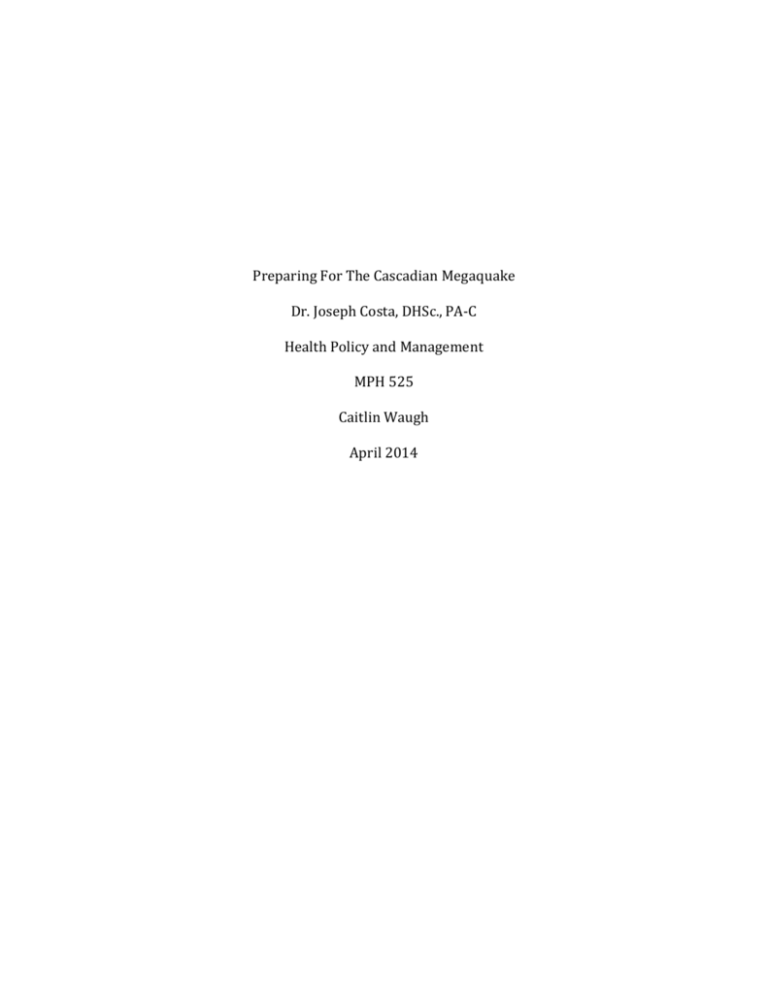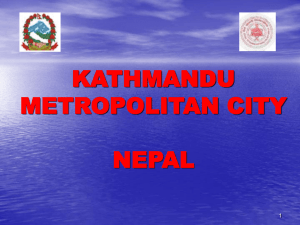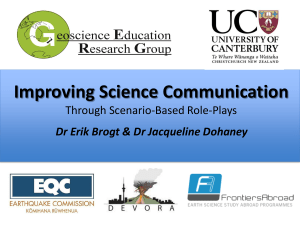Week 6 Final Paper - Students, Alumni and Friends
advertisement

Preparing For The Cascadian Megaquake Dr. Joseph Costa, DHSc., PA-C Health Policy and Management MPH 525 Caitlin Waugh April 2014 2 Table of Contents Chapter Page 1. Introduction……………………………………………………………………………………………3 Background………………………………………………………………………………….3 The Threat……………………………………………………………………………………3 Oregon is far from safe………………………………………………………………….4 Japan……………………………………………………………………………………………5 2. Communication……………………………………………………………………………………….5 Theories……………………………………………………………………………………….5 Communicating the Threat……………………………………………………………6 3. Preparation……………………………………………………………………………………………..7 Great ShakeOut……………………………………………………………………………..7 Energy Rebates……………………………………………………………………………..8 Zombies………………………………………………………………………………………..9 4. Communication During the Disaster…………………………………………………………9 Evacuation…………………………………………………………………………………..10 Getting Critical Information to the Public………………………………………10 5. Conclusion……………………………………………………………………………………………..11 References……………………………………………………………………………………………………12 3 Chapter 1 Introduction Background A disaster is a sudden event that causes damage and loss. It causes serious disruption to society resulting in both human suffering and environmental degradation (CDC, 2012). The frequency of natural disasters has been increasing. From 2000 to 2009 there have been 3 times as many natural disasters as there was between 1980 and 1989, affecting 217 million people per year (Leaning & Guha-Sapir, 2013). Since the welfare of citizens is threatened in the event of a disaster, curtailing the damage and responding to the threat of a disaster is a public health responsibility. There is no greater time to respond to a natural disaster than prior to its occurrence. Off the coast of Oregon looms a threat of an impending earthquake. Research has suggested that an earthquake with a magnitude greater than 8.0 will result in massive loss of human life and structural and economic damage. Proper communication prior to the event can help minimize risk and save lives. This paper will explore different types of communication, how they apply to earthquake preparedness scenarios and suggest methods to communicate the public health threat of an earthquake prior, during and after its occurrence. The Threat The Cascadia Subduction Zone is located about 50 miles off the Oregon Coast. It is characterized by the subduction of the Juan de Fuca tectonic plate underneath the North American plate (USGS, 2012). Based on the results of a 13-year geological study of the 4 region, it is estimated that in the next 50 years an earthquake that rivals the intensity of the Tohoku earthquake will occur off the coast of southern Oregon (Goldfinger et al, 2012). The likelihood of this earthquake occurring is estimated at 40%. Over the past 10,000 years there have been 19 earthquakes that ranged in magnitude of 8.7 to 9.2 from Northern California to Vancouver Island. There have been an additional 22 earthquakes from 8.0 to 8.7 in this same time frame (Goldfinger et al, 2012). Oregon is far from safe The Oregon Seismic Safety Policy Administration Commission (OSSPAC) released a report that estimated the damage Oregon would sustain if the earthquake and subsequent tsunami occurred today. Their findings suggest that Oregon is far from ready for the impacts of such an episode. According to their study they estimate: Fatalities ranging from 1,250 to more than 10,000 due to the combined effects of earthquake and tsunami, tens of thousands of buildings destroyed or damaged so extensively that they will require months to years of repair, tens of thousands of displaced households, more than $30 billion in direct and indirect economic losses (close to one-fifth of Oregon’s gross state product), and more than one million dump truck loads of debris (Yu et al, 2013). Oregon is not structurally prepared and neither are its citizens. There are many critical services that will be deeply impacted by such an event. The OSSPAC’s report estimates that some people will be without drinking water or sewage for up to three years. Healthcare facilities are estimated to be unable to provide service for at least 18 months and it can take 3 to 6 months to restore electricity (Yu et al, 2013). Japan 5 When the 8.9 earthquake occurred in Japan in 2011, the damage sustained from the massive quake was minor in comparison to the damage caused by the tsunami. Despite the tsunami the death toll in Japan was still significantly less than the death toll after the Haitian earthquake. This is an example of the different levels of preparedness. Much of this can be attributed to the advanced communication system Japan has in place. As soon as Japan detects an earthquake, television channels are replaced with live news coverage and SMS messages are automatically sent out to all cell phones (Rauhala, 2011). Citizens are frequently drilled from the time they are young. When an earthquake does occur, muscle memory essentially takes over and the event they practiced so often is not so intimidating or frightening. Chapter 2 Communication Theories Communication for Persuasion Theory Persuasion is defined as the use of communication to modify or change someone’s belief. In order to utilize persuasion tactics, there must be a goal and intent to achieve that goal. The recipient hearing the persuasive communication must have free will (Dainton & Zalley, 2004). Persuasion theory can be utilized in public health communication by highlighting facts that are frightening or particularly relevant. By overstressing earthquake statistics it plays on the emotions of the public. Cultivation Theory of Mass Media Cultivation theory is an idea that media gradually changes a persons perceptions and ideas. The combined effects of massive consumption of media over time subtly 6 change a person’s perception and therefore the community (Cultivation Theory, n.d.). By exposing people frequently to earthquake preparedness announcements, it will begin to have an impact on their approach to preparedness. If a member of the population drives by a billboard that promotes preparedness every day to work and they hear a radio ad for creating an evacuation plan, it will begin to mold their way of thinking. Mass Communication Theory This is a unique time period. Now, more than ever before, media is a part of our daily life. Mass communication is the way in which public entities release information to a large part of the population (Pearce, 2009). It is imperative that a public health message reaches the intended target. The Japanese alarm system is a great example of the utilization of mass communication. Communicating the Threat Why aren’t we prepared? As stated earlier, natural disasters are happening with increasing frequency. With the ability to access news media in a moments notice, Americans have seen the devastation of Hurricane Katrina, the earthquake in Haiti and the earthquake and tsunami in Japan. Yet, despite the instant access to all of these disasters, Americans remain underprepared. Public Risk Perception For a member of the general public to be prepared for an event of this nature they need to secure materials and create plans before an event strikes. Past events have showed that people are generally not prepared for events and Oregonians are no 7 exception. In order to effectively communicate, public health officials need to understand the way in which members of the general public perceive threats. In a paper written by Slovic, Kunreuther & White, the researchers attempt to understand how humans react to the risk of natural disaster and why they make certain detrimental choices. Many people affected by natural disaster rationalized their assumption of experiencing another disaster in many different ways. Some people believed that these events occur in cycles and that they would not fall into an interval. Others believed in a law of averages and told the researchers that since there was a recent flood, they were unlikely to experience another flood soon. They found that only those with repeated exposures to naturally devastating weather would change their behavior. Japan is an excellent example of this. Due to the frequent earthquakes, they have one of the most advanced responses to earthquakes. Research in this field has shown that an individual’s decision to not be prepared exasperates the tragedy of natural events because they choose to make themselves vulnerable. Understanding this will allow for more effective communication. Chapter 3 Preparation Great ShakeOut Oregon officials are very aware of the looming threat of the Cascadian Megaquake. Every October, there is an event called the Great ShakeOut. Its intention is to increase awareness and “practice” what to do in the instance of an earthquake. At 10:16 on October 16th participants will stop, drop and cover for 60 seconds. This is a great program however its participation is limited. Only 22,000 people registered in 8 Oregon for the 2013 event. Increasing involvement would be advantageous to grow public knowledge and encourage more participation in public preparedness practices. I recommend that public schools be required to participate. Students should be given a homework assignment that involves the participation of their entire family. The assignment would encourage parents and children to talk about what type of escape or evacuation plan they would need to implement. At school, after the drill, students can participate in creating their own “bug out bag.” Students generally have backpacks at school. For the remainder of the day they can replace their books and homework with approved objects from FEMA’s suggested items list. This includes water, food, first aid kits, maps and a flashlight. By reaching out to children, it is also possible to educate adults. Local and state governments should take a more active role. Police and Firefighters can host local events on the 16th. Closing a main road and hosting an event will not only bring members of the community together, but it could demonstrate the difficulties that will exist if roads are destroyed or shut down. Organizers should recruit local churches to participate. Churches can hold special services that help facilitate the communication around earthquake preparedness. Parishioners should be encouraged to create their own personal plans but also to contribute to the development of an emergency plan for their church. Energy Rebates Energy rebates are available for a variety of reasons. By purchasing specially approved appliances or light bulbs, it is possible to receive a credit on an energy, water or gas bill. I propose that a rebate be made available to people that inquire for special 9 training on how to turn off their utilities in the event of an earthquake. Energy bills climb drastically during the winter months. By advertising the potential for a rebate, people would be inclined to take the few minutes out of their day to learn useful information and save money. This inherently brings awareness to the potential for an earthquake in the region. Zombies There is no denying how trendy zombies are right now. Following the CDC’s example, public health officials should use the popularity of the zombie craze to help prepare people for natural disasters such as the Cascadian Megaquake. Oregon also has a very strong running culture. Local public health professionals would be tasked to create a zombie run. Participants would run through an obstacle course filled with the “walking dead.” At the end of the race an expo would be set up. Participants could include organizations such as the American Red Cross, Sporting Goods Stores and the Citizen Corps. This would allow members of the community to interact in a more personal environment with experts in the field of preparedness. Post race refreshments would consist of bottled water and MRE’s. As discussed earlier in regards to mass communication, it is important that public health officials are able to be relevant. This will increase communication and draw attention to an important topic. Zombies are relevant. Zombies are also fun. By making a potentially stressful topic fun it might encourage people to be more proactive. Chapter 4 Communication During the Disaster Evacuation 10 During Superstorm Sandy and Hurricane Katrina, citizens were given the mandatory evacuation notice. Many people did not heed the communication to evacuate. I propose these reasons that people might decide to stay: Inability to evacuate due to lack of transportation or funds Inability to comprehend warning due to language barriers Loss of sensitivity to natural disasters or does not take them seriously Although the third on this list is much harder to prepare for, I believe that the first two issues can be addressed by public health officials. First, it is absolutely imperative that the most advanced warning is available. Also, having a plan is necessary. Public health officials must have a plan in place to communicate to all effected citizens. In 2006 DHS reported that only 10 percent of states and 12 percent of urban communities have addressed evacuating their population (GAO, 2006) Getting Critical Information to the Public Building a prominent social media presence will be very advantageous to public health officials trying to communicate during the Cascadian Megaquake. After the Boston Marathon bombing, I refreshed my news feed incessantly to hear news that my best friend Erica was not injured. Calls into and out of the area where shut down. However, Facebook prevailed and allowed her to update her friends and family that she was all right. There were more than 20-million Superstorm Sandy related Twitter posts. When the Boston Police Department tweeted “CAPTURED!!!” after they arrested the bombing suspect, that tweet was shared 140,000 times (Maron, 2013). By having an active social media presence before an earthquake, people will be more likely to follow important public health departments such as Oregon Health Authority. 11 Despite the most well executed plans, panic is inevitable in an emergency situation. However, if recent disasters such as 9/11, Superstorm Sandy or the Boston Marathon bombing have shown us anything is that people want to rise to the occasion. This is facilitated through mass communication and social networking. Public health officials should preemptively have programs in place that allow for people to help during a crisis. Chapter 5 Conclusion Unfortunately both the general population and the United States government currently respond to natural disasters by being reactionary. Public Health officials are well aware of this. Support for hazard mitigation is strongest after a disaster. Improving the earthquake resiliency of a building would do little after it has been structurally damaged beyond repair. In the case of Superstorm Sandy, FEMA only readdressed flood zones after the damage had been done. By effectively communicating preparedness solutions and encouraging people to actively participate in their personal readiness it can help reduce the estimated 10,000 deaths that are expected to occur when the Cascadia Megaquake strikes. In this paper I proposed that public health officials create events that teach people about preparedness while fostering community. 12 References Cascadia Subduction Zone. (2012). USGS. Retrieved from http://earthquake.usgs.gov/research/structure/crust/cascadia.php. Cultivation Theory. (n.d.). University of Twente. Retrieved from http://www.utwente.nl/cw/theorieenoverzicht/Theory%20Clusters/Media, %20Culture%20and%20Society/Cultivation_Theory-1/. Dainton, M. & Zelley, E.D. (2004). Apply Communication Theory for Professional Life: A Practical Introduction. Sage Publications. Disaster Training and Response. (2012). Centers for Disease Control and Prevention. Retrieved from http://www.cdc.gov/nceh/hsb/disaster/training.htm. Goldfinger, C., Nelson, C.H., Morey, A.E., Johnson, J.E., Patton, J.R., Karabanov, E…Vallier, T. (2012). Turbidite event history-methods and implications for Holocene paleoseismicity of the Cascadia Subduction Zone. USGS. Retrieved from http://pubs.usgs.gov/pp/pp1661f/. Leaning, J. & Guha-Sapir, D. (2013). Natural disasters, armed conflict, and public health. The New England Journal of Medicine, 369, 1836-1842. Maron, D.F. (2013). How social media is changing disaster response. Scientific American. Retrieved from http://www.scientificamerican.com/article/howsocial-media-is-changing-disaster-response/. Pearce, K.J. (2009). Media and Mass Communication Theories. Encyclopedia of Communication Theory. Retrieved form http://knowledge.sagepub.com/view/communicationtheory/n231.xml. Rauhala, E. (2011). How Japan became a leader in disaster preparation. TIME. Retrieved from http://content.time.com/time/world/article/0,8599,2058390,00.html. Slovic, P., Kunreuther, H. & White, G.F. (1974). Decision rocesses, rationality, and adjustment to natural hazards. Retrieved from http://www.scarp.ubc.ca/sites/default/files/Slovic%20et%20al.%201974.P DF. Transportation-Disadvantaged populations: Actions needed to clarify Responsibilities and Increase Preparedness for Evacuations. (2006). Government Accountability Office. Retrieved from http://www.gao.gov/products/GAO-07-44. 13 References (cont) Yu, K., Wilson, J., Boone, D., Ek-Collins, G., Farrington, C.., Girod, F….Williams, G. (2013). The Oregon Resilience Plan. Oregon Seismic Safety Policy Advisory Committee. Retrieved from http://www.oregon.gov/OMD/OEM/osspac/docs/Oregon_Resilience_Plan_d raft_Executive_Summary.pdf.








